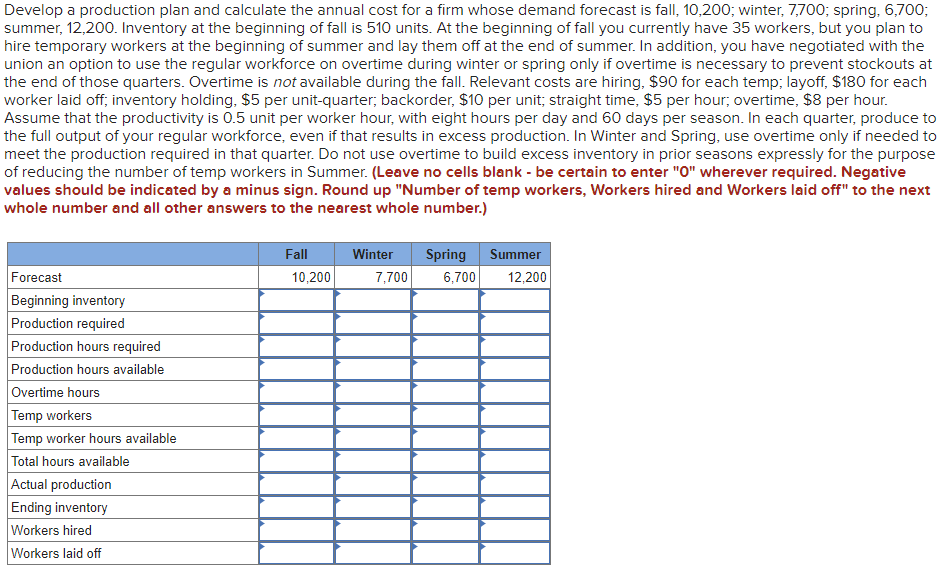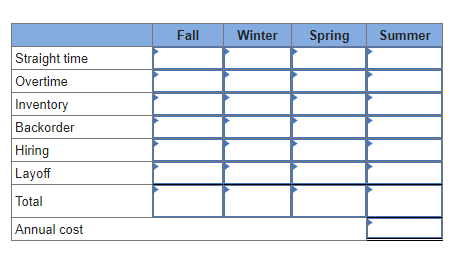ume that the productivity is 0.5 unit per worker hour, with eight hours per day and 60 days per season. In each quarter, produce full output of your regular workforce, even if that results in excess production. In Winter and Spring, use overtime only if needed et the production required in that quarter. Do not use overtime to build excess inventory in prior seasons expressly for the purpe educing the number of temp workers in Summer. (Leave no cells blank - be certain to enter "O" wherever required. Negative ies should be indicated by a minus sign. Round up "Number of temp workers, Workers hired and Workers laid off" to the ne ple number and all other answers to the nearest whole number.) Fall Winter Spring Summer 6,700 ecast ginning inventory duction required 10,200 7,700 12,200
ume that the productivity is 0.5 unit per worker hour, with eight hours per day and 60 days per season. In each quarter, produce full output of your regular workforce, even if that results in excess production. In Winter and Spring, use overtime only if needed et the production required in that quarter. Do not use overtime to build excess inventory in prior seasons expressly for the purpe educing the number of temp workers in Summer. (Leave no cells blank - be certain to enter "O" wherever required. Negative ies should be indicated by a minus sign. Round up "Number of temp workers, Workers hired and Workers laid off" to the ne ple number and all other answers to the nearest whole number.) Fall Winter Spring Summer 6,700 ecast ginning inventory duction required 10,200 7,700 12,200
Chapter19: Pricing Concepts
Section: Chapter Questions
Problem 6DRQ
Related questions
Question

Transcribed Image Text:Develop a production plan and calculate the annual cost for a firm whose demand forecast is fall, 10,200; winter, 7,700; spring, 6,700;
summer, 12,200. Inventory at the beginning of fall is 510 units. At the beginning of fall you currently have 35 workers, but you plan to
hire temporary workers at the beginning of summer and lay them off at the end of summer. In addition, you have negotiated with the
union an option to use the regular workforce on overtime during winter or spring only if overtime is necessary to prevent stockouts at
the end of those quarters. Overtime is not available during the fall. Relevant costs are hiring, $90 for each temp; layoff, $180 for each
worker laid off; inventory holding, $5 per unit-quarter; backorder, $10 per unit; straight time, $5 per hour; overtime, $8 per hour.
Assume that the productivity is 0.5 unit per worker hour, with eight hours per day and 60 days per season. In each quarter, produce to
the full output of your regular workforce, even if that results in excess production. In Winter and Spring, use overtime only if needed to
meet the production required in that quarter. Do not use overtime to build excess inventory in prior seasons expressly for the purpose
of reducing the number of temp workers in Summer. (Leave no cells blank - be certain to enter "0" wherever required. Negative
values should be indicated by a minus sign. Round up "Number of temp workers, Workers hired and Workers laid off" to the next
whole number and all other answers to the nearest whole number.)
Fall
Winter
Spring
Summer
Forecast
10,200
7,700
6,700
12,200
Beginning inventory
Production required
Production hours required
Production hours available
Overtime hours
Temp workers
Temp worker hours available
Total hours available
Actual production
Ending inventory
Workers hired
Workers laid off

Transcribed Image Text:Fall
Winter
Spring
Summer
Straight time
Overtime
Inventory
Backorder
Hiring
Layoff
Total
Annual cost
Expert Solution
This question has been solved!
Explore an expertly crafted, step-by-step solution for a thorough understanding of key concepts.
This is a popular solution!
Trending now
This is a popular solution!
Step by step
Solved in 2 steps with 1 images

